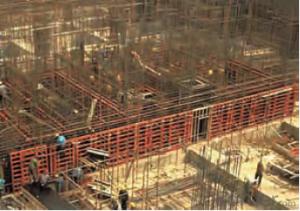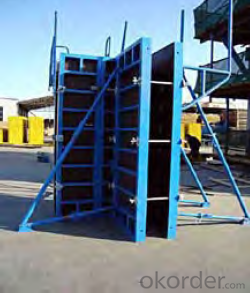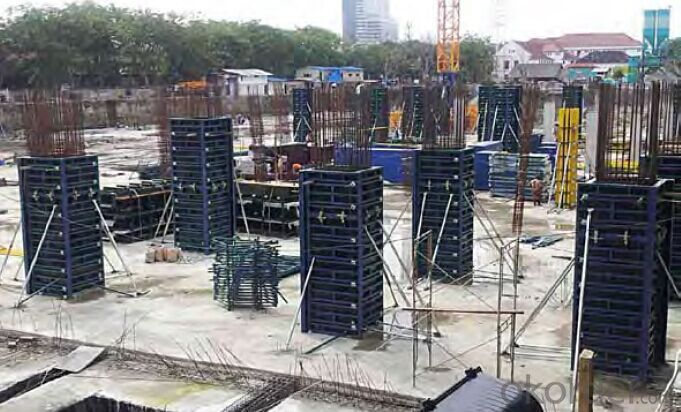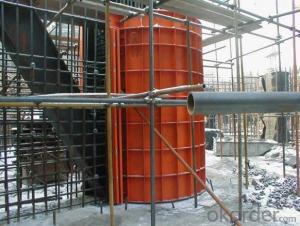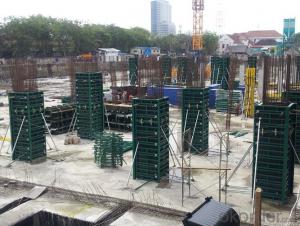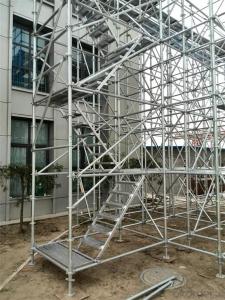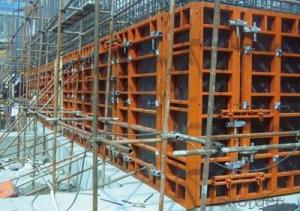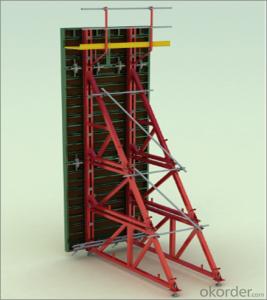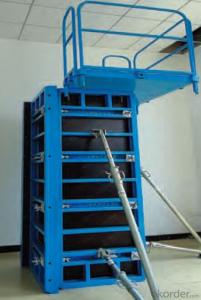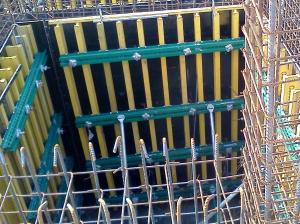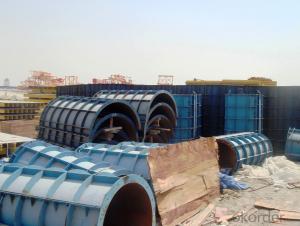Steel Frame Easy Connection Formwork with Adjustable Steel Clamp
- Loading Port:
- Shanghai
- Payment Terms:
- TT OR LC
- Min Order Qty:
- 1 m²
- Supply Capability:
- 10000000 m²/month
OKorder Service Pledge
OKorder Financial Service
You Might Also Like
1. Structure of Steel Frame Formwork
There is a prizing part designed in the corner, which can help to position and remove formwork easily.
The plywood is screwed on from the back when connecting frame and plywood, so the surface of the finished concrete is perfect.
The formwork series are a complete system with a full set of accessories, and can be set up flexibly according to project demand.
2. Main Features of Steel Frame Formwork
Light weight
High strength
High standardized system
Easy connection with adjustable steel clamp
Convenient and fast corner formwork
Flexible to assemble and application
3. Steel Frame Formwork Images


4. Steel Frame Formwork Specification
-The steel frame formwork is plywood covered with hollow steel. The plywood is 18 mm thick.
-The frame is highly strengthened, and the wall formwork can bear lateral pressure 60 KN/m2 while the column formwork can bear 80 KN/m2.
-As a standardized system, it is flexible to assemble , wood batten can be filled to satisfy the need f of non-standard size.
-The adjustable steel clamp is convenient to use, and can hold tightly.
5. FAQ of Steel Frame Formwork
1) What can we do for you?
.We can ensure the quality of the vinyl banner and avoid extra expenses for customers.
.We can provide you the professional design team.
.We can provide fashionable and newest styles for you.
.We can design the artwork for you.
. Please feel free to customize.
2) What promises can be done by us?
. If interested in Steel Frame Formwork , please feel free to write us for any QUOTE.
. If printing required, please advise asap because the whole set need much more time to complete.
. Please DO check goods when courier knocks your door and contact us asap if any issue.
3) What about of our after-sale service?
. Response will be carried out in 24hours after receiving any complain or request.
. Steel Frame Formwork GK120 cost can be refund after order is confirmed.
. If the products are not based on the requirements, there will be the relevant compensations made for you.
4) What about the package and shipping time?
.Packing: As Customer's Requirements
.Shipping: We have various shipping ways for our customers, such as express which including TNT, DHL, FEDEX, UPS, EMS, etc. ; by air/ sea, and we are VIP of these express.
.Shipping time:
Normally small orders, it just 10-15 business days to arrive your hand; When comes to the customs declaration, it may need 7 days.
Other mass qty of Steel Frame Formwork , we send them out by sea or by air to sea port or air port to save some shipping freight for our customers. By ocean, it may need 45~60days, by air, it may need 25~40days.
- Q: Can steel frame formwork be used for tunnel construction?
- Yes, steel frame formwork can be used for tunnel construction. Steel frame formwork offers strength, durability, and stability, making it suitable for the demanding conditions of tunnel construction. The steel frames can be easily assembled and disassembled, allowing for efficient and cost-effective construction of tunnels. Additionally, steel formwork can be customized to meet the specific requirements and dimensions of tunnel projects.
- Q: Can steel frame formwork be used for foundations?
- Yes, steel frame formwork can be used for foundations. Steel frame formwork is a versatile and durable system that can be easily adjusted to accommodate different foundation shapes and sizes. It provides a strong and stable framework for pouring concrete, ensuring accurate and precise construction of foundation structures. Steel frame formwork is commonly used in larger construction projects where speed, strength, and efficiency are important factors. It offers the advantage of being reusable, which makes it a cost-effective option for foundation construction. However, it is important to ensure that the steel frame formwork is properly designed and installed to withstand the loads and pressures exerted during the concrete pouring process.
- Q: How does steel frame formwork affect the overall sustainability goals of a construction project?
- The overall sustainability goals of a construction project can be significantly impacted by the use of steel frame formwork. Firstly, steel is an incredibly durable material that can withstand the harsh conditions of construction, resulting in a longer lifespan for the formwork system. This increased durability reduces the need for frequent replacements, which in turn saves resources and decreases waste. Additionally, steel frame formwork is reusable, meaning it can be dismantled after use and utilized again in future projects. This not only reduces the demand for new formwork materials but also minimizes the amount of waste generated during the construction process. By promoting the reuse of formwork, steel frames contribute to a circular economy approach that aims to reduce resource consumption and waste generation. Furthermore, the use of steel frame formwork facilitates efficient and precise construction processes. The formwork system is designed to provide accurate dimensions and smooth finishes, resulting in reduced material waste and energy consumption. Moreover, steel is a highly recyclable material, meaning that once it reaches the end of its life cycle, it can be easily recycled and used in the production of new steel products. This reduces the demand for virgin materials and the associated environmental impact. Lastly, steel frame formwork offers flexibility in design and construction, enabling innovative and sustainable building practices. Its strength and versatility allow for the construction of complex and efficient structures, such as high-rise buildings or large-span structures, which can maximize energy efficiency and minimize the overall environmental impact of the project. In conclusion, the use of steel frame formwork positively impacts the sustainability goals of a construction project by promoting durability, reusability, efficiency, and recyclability. Its utilization contributes to the reduction of resource consumption, waste generation, and environmental impact, aligning with the principles of sustainable construction practices.
- Q: How does steel frame formwork handle concrete pouring in congested areas?
- The steel frame formwork system is an effective and versatile solution for pouring concrete in crowded areas. It possesses various advantages that enable it to effectively handle such situations. To begin with, the steel frame formwork is highly adaptable and can be tailored to meet the specific requirements of congested areas. It can be easily adjusted to fit tight spaces and irregular shapes. This flexibility ensures seamless installation and usage, even in areas with limited accessibility. Furthermore, the steel frame formwork is lightweight yet sturdy, making it easier to handle and transport within congested areas. Its lightweight nature allows for quick assembly and dismantling, saving time and effort during the construction process. Moreover, the strength of the steel frame ensures stability and durability, even under the pressure of concrete pouring. Additionally, the steel frame formwork system is designed to provide a smooth and uniform surface finish. This is particularly advantageous in crowded areas with limited space, as it eliminates the need for additional finishing work like plastering or rendering. The system also facilitates easy placement of reinforcement bars, ensuring proper reinforcement throughout the structure. In terms of safety, the steel frame formwork guarantees a secure working environment for construction workers in crowded areas. It provides a stable platform for pouring concrete, minimizing the risk of accidents or injuries during the construction process. Additionally, the system is designed to prevent leakage and seepage of concrete, ensuring an efficient and effective pouring process. In conclusion, the steel frame formwork system is an excellent choice for handling concrete pouring in crowded areas. Its adaptability, lightweight yet strong construction, smooth finishing capabilities, and safety features make it a dependable option for construction projects that require efficient concrete pouring in tight spaces.
- Q: Can steel frame formwork be used for both straight and curved walls?
- Yes, steel frame formwork can be used for both straight and curved walls. Steel frame formwork is highly versatile and can easily be adjusted to create various shapes and sizes. It is designed to provide stability and support during the concrete pouring process, ensuring that the walls are formed accurately and with precision. The steel frame formwork can be easily manipulated to create both straight and curved walls, making it a suitable choice for various construction projects.
- Q: Can steel frame formwork be used in areas with limited access to utilities?
- Yes, steel frame formwork can be used in areas with limited access to utilities. Unlike traditional formwork systems that require water and electricity for setup and removal, steel frame formwork is designed to be easily assembled and disassembled without the need for additional utilities. It is a versatile and portable solution that can be used in remote locations or areas where access to utilities is limited. Steel frame formwork is typically lightweight and can be transported to the site manually or with minimal machinery, making it suitable for areas with limited infrastructure. Additionally, steel frame formwork can be reused multiple times, reducing the need for constant supply of utilities during construction. Overall, steel frame formwork provides a practical and efficient solution for construction projects in areas with limited access to utilities.
- Q: Steel frame wood fire doors are graded? Grade A, B, C?
- The material of the product is consistent with the test report; 5, the product performance parameters are consistent with the test report. Three, the product performance test items and the unqualified description of 1 fire door code MFM 1021 B L S K (1.2h) 5 armour a wooden fire door B (0.9h) the code c (0.6h) fireresistance grade hole width code 5 clockwise to close the entrance code 6 counterclockwise direction switch under the direction of code box D single s double cutting cutting cutting code with bright window doors with glass 2 inspection items and unqualified inspection items required description unqualified appearance should be complete without damage, the net surface appearance is not complete, damaged, surface net light, light, no dig burr and hammer India; cutting angle, planer marks, burr and hammer India; cutting angle, lax seam welds should be tight formation; real smooth appearance; in place should be provided in the provisions of the product marks, No product marks, quality inspection quality inspection marks and quality certification (certification mark and quality certification (accreditation) qualified mark) mark. Annals. Size regulation should not exceed the shape description of sample size lattice dimensions should describe the shape of sample size size thickness should be more than the door door fan in the door leaf thick description of sample thickness
- Q: How does steel frame formwork contribute to better concrete consolidation in deep sections?
- Steel frame formwork contributes to better concrete consolidation in deep sections through various factors: 1. Rigidity and stability: The steel frame provides strong structural support to withstand the pressure exerted by the wet concrete during pouring. This rigidity prevents any deformation or displacement of the formwork, ensuring that the concrete is contained within the desired shape, especially in deep sections where the weight of the concrete can be significant. 2. Enhanced vibration transfer: Steel formwork has excellent vibration transfer properties, which allows for efficient and effective consolidation of the concrete. Vibrators can be attached directly to the steel frame, enabling the vibrations to penetrate deep into the concrete, eliminating air voids and ensuring proper compaction even in hard-to-reach areas. 3. Improved concrete flow: Steel formwork systems are designed with smooth surfaces that facilitate the flow of concrete, especially in deep sections. The absence of rough or uneven surfaces reduces friction, allowing the concrete to flow easily and uniformly within the formwork. This improved flow helps to eliminate any potential voids or honeycombing, resulting in a denser and stronger concrete structure. 4. Reduced formwork deflection: Deep sections of concrete can exert significant pressure on the formwork, leading to deflection or deformation. Steel frame formwork, with its high strength and stiffness, resists such deflection, maintaining the desired shape and preventing any bulging or bending of the formwork. This stability ensures that the concrete consolidation process remains consistent and uniform throughout the entire structure. 5. Enhanced safety: Steel frame formwork provides a secure and stable working platform for the construction team during the pouring and consolidation process. The robustness of the steel frame reduces the risk of accidents or formwork failures, allowing workers to focus on achieving proper concrete consolidation without concerns about formwork stability. In summary, steel frame formwork contributes to better concrete consolidation in deep sections by providing rigidity and stability, enhancing vibration transfer, improving concrete flow, reducing formwork deflection, and ensuring worker safety. This results in a high-quality and durable concrete structure with minimal defects and improved overall performance.
- Q: Can steel frame formwork be used for both vertical and horizontal concrete elements?
- Indeed, it is possible to utilize steel frame formwork for both vertical and horizontal concrete elements. This versatile and enduring system can be effortlessly assembled and modified to accommodate a diverse range of concrete structures of different shapes and sizes. The steel frames offer ample strength and stability to withstand the weight and pressure exerted by the wet concrete during pouring and curing. Consequently, it is a fitting choice for the construction of walls, columns, beams, slabs, and other concrete elements, whether they are positioned vertically or horizontally. The employment of the steel frame formwork system facilitates prompt and efficient construction, ensuring exceptional quality outcomes while simultaneously reducing construction time and expenses.
- Q: How does steel frame formwork contribute to the overall efficiency of concrete placement and compaction?
- There are several ways in which steel frame formwork enhances the efficiency of concrete placement and compaction. Firstly, it offers a stable and rigid structure that preserves the shape and dimensions of the concrete elements being formed. This guarantees precise and accurate concrete placement, leading to a more efficient construction process. The steel frames are specifically engineered to withstand the pressure exerted by the wet concrete, preventing any deformation and maintaining the desired structure shape. Secondly, steel frame formwork enables easy and swift assembly and disassembly. The frames are typically prefabricated and can be conveniently transported and assembled on-site. This saves time and labor, thereby enhancing construction efficiency. Moreover, the steel frame formwork can be reused multiple times, further reducing the overall time and cost of the project. Furthermore, steel frame formwork provides a smooth and uniform surface for concrete compaction. The rigid structure of the steel frames prevents any bulging or sagging of the formwork, ensuring that the concrete is evenly distributed and compacted. Consequently, this results in a superior quality finish and reduces the need for additional compaction efforts, saving time and resources. Lastly, steel frame formwork allows for easy access to the concrete during the placement and compaction process. The frames can be designed with openings and access points, providing convenient access for workers and equipment. This facilitates efficient pouring and compaction, as workers can easily reach all areas of the formwork, ensuring proper consolidation and eliminating the risk of voids or weak spots in the concrete. To conclude, steel frame formwork plays a crucial role in enhancing the overall efficiency of concrete placement and compaction. It provides stability, precision, reusability, and convenient access, resulting in a streamlined construction process and a higher quality end product.
Send your message to us
Steel Frame Easy Connection Formwork with Adjustable Steel Clamp
- Loading Port:
- Shanghai
- Payment Terms:
- TT OR LC
- Min Order Qty:
- 1 m²
- Supply Capability:
- 10000000 m²/month
OKorder Service Pledge
OKorder Financial Service
Similar products
Hot products
Hot Searches
Related keywords

